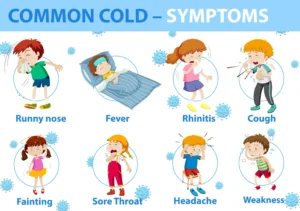 The common cold is a viral infection that affects the upper respiratory tract. While it’s often mild and self-limiting, understanding its signs is crucial for effective management and prevention of complications.
The common cold is a viral infection that affects the upper respiratory tract. While it’s often mild and self-limiting, understanding its signs is crucial for effective management and prevention of complications.
Today, we’ll explore the common symptoms of a cold and provide insights into how to recognize and manage them.
Understanding the Common Cold
The common cold is primarily caused by rhinoviruses, although other viruses such as coronaviruses and adenoviruses can also contribute to cold-like symptoms. It is highly contagious and spreads through respiratory droplets when an infected person coughs, sneezes, or talks.
Symptoms of the Common Cold
- Runny or Stuffy Nose. One of the hallmark symptoms of a cold is nasal congestion, often accompanied by a runny nose or postnasal drip. This occurs as a result of inflammation of the nasal passages and increased mucus production.
- Sneezing. Sneezing is a common symptom of the common cold and serves as the body’s mechanism for expelling irritants and infectious agents from the respiratory tract.
- Sore Throat. A scratchy or sore throat is often experienced at the onset of a cold and may persist throughout the illness. It can be caused by irritation and inflammation of the throat tissues due to viral infection.
- Cough. A dry or productive cough may develop as the cold progresses, especially as mucus accumulates in the throat and airways. Coughing helps clear the respiratory passages of excess mucus and irritants.
- Fatigue. Feelings of tiredness and fatigue are common during a cold, as the body’s immune system works to fight off the viral infection. Rest and adequate hydration are essential for supporting recovery.
Managing Cold Symptoms
- Rest. Getting plenty of rest allows the body to conserve energy and focus its resources on fighting off the viral infection. Take breaks as needed and avoid overexertion.
- Stay Hydrated. Drinking plenty of fluids helps thin mucus secretions, making it easier to clear congestion and stay hydrated. Opt for water, herbal teas, broths, and electrolyte-rich drinks.
- Use Saline Nasal Sprays. Saline nasal sprays or nasal irrigation with a saline solution can help alleviate nasal congestion and clear mucus from the nasal passages.
- Over-the-counter Medications. Over-the-counter cold medications such as decongestants, antihistamines, and pain relievers may help alleviate symptoms such as nasal congestion, sneezing, and sore throat. However, always read the label and follow the dosing instructions carefully.
- Humidify the Air. Using a humidifier or steam inhalation can help moisturize the airways and relieve nasal congestion and throat irritation.
Recognizing the common symptoms of a cold and knowing how to manage them effectively is essential for minimizing discomfort and promoting recovery. While most colds resolve on their own within a week or two, practicing good hygiene, staying hydrated, and getting adequate rest can help support the immune system and facilitate healing. If symptoms persist or worsen, consult a healthcare professional for further evaluation and guidance.
Picture Credit: Freepik
